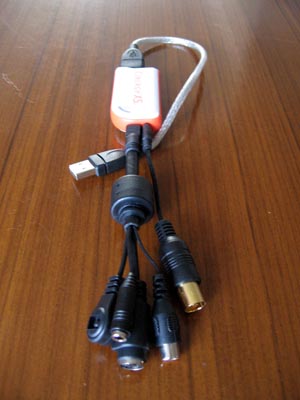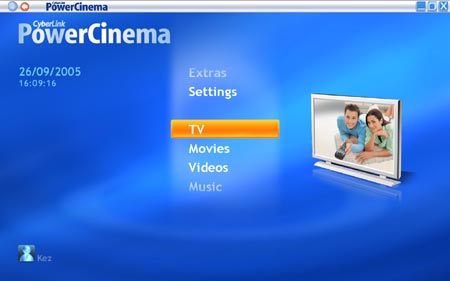Usage
Before we report on the usage experience of the product, here's a rundown of the system it was used with:
| Model | Acer TravelMate 4502WLMi |
| Screen | 15.4in TFT 1280x800 wide screen |
| Processor | Intel Pentium M 'Dothan' 1.6GHz |
| Chipset | Intel Centrino |
| Memory | 2x256MB DDR333 |
| Graphics Card | ATI Mobility Radeon 9700 64MB |
| Hard disk | 60GB Seagate Momentus 4200.2 |
| Operating System | Windows XP Pro SP2 |
| TV Tuner drivers | 3.5.0906 |
A mobile tuner for a mobile device, which, ironically, works best if you're near a fixed antenna. Terratec advises 2GHz of processing power is necessary for this card, but a 1.6GHz Pentium-M is going to stand up to at least a 2.0GHz Pentium 4, so we felt safe. Using a laptop did allow us to test performance at lower clock speeds, thanks to SpeedStep. Under-spec'd CPUs will give you a sluggish response and sound/video glitches during television viewing (digital, at least) if what we witnessed at lower clock speeds is anything to go by. However, CPU usage results suggest that it's more the software than the video decoding/encoding to blame, as we'll see shortly.
Once we'd updated the drivers to those listed above - courtesy of Terratec's website - channel scanning pulled in more stations, so we strongly recommend keeping the drivers for this tuner up to date.
When attached to the side of a laptop, the Cinergy Hybrid USB XS is as vulnerable to being caught as any other dongle-like USB device, so we'd recommend using the supplied USB extension cable to play it safe. That does mean, once you've hooked up aerial, input cable and extension cable, that the tuner is hard to find among the connected spaghetti:

PowerCinema has a very easy to follow setup wizard, which helps choose screen aspect ratio, which tuner to use (remember this one supports analogue and DVB-T, which are presented to the system as two capture devices) and how fancy you want the menus to be (if you're worried about CPU usage.) Now would be a good time to note that swapping between analogue and digital without a restart can, after a couple of tries, bring the system to a crawl until the tuner is removed. Perhaps a driver bug that needs attention, or perhaps PowerCinema isn't changing capture device in a friendly way? That aside, it's a trivial issue as you're not going to want to change capture device as much as we needed to in testing.
PowerCinema supports DVD, music and radio playback along with TV tuning and a host of other features. It's very Windows Media Centre Edition-esque, no doubt deliberately. Also included, and styled to compliment PowerCinema, is MakeDVD, allowing you to burn recorded shows and other videos to DVD, VCD or SVCD at varying qualities.
The above picture of a man on the telly (click for a png version) demonstrates the quality. The 640x480 signal is scaled up to fit on the screen, which doesn't look all that bad.
Time-shifting is supported by the tuner and software, so turn it on to experience the joys of TV you can rewind and pause. On the test system, pausing digital television resulted in CPU usage hovering around four to seven per cent. Playing back time-shifted digital television resulted in around 25 per cent CPU usage. Remember that with time-shifting enabled the video stream is being decoded and viewed as well as being recorded to disk. CPU usage, then, isn't something to be concerned about. Indeed, the interface to PowerCinema takes up more CPU power to delivery its fancy menu system.
At times, when fast forwarding or if a background application decided it was time to load, time-shifting would forget quite where it was meant to be, resulting in being thrown back to the beginning or end of the recording. Is this the software or the card at issue? Hard to say, but a nuisance nonetheless. Our advice is, if you're running the tuner on a general-purpose system, make sure nothing is going to be happening in the background while you sit back and watch telly.
An Electronic Program Guide (EPG) is supported if you're in digital mode. It allows you to view program details, schedule recordings or change channel. The small thumbnail of the current channel stays on screen, should you possess the ability to read TV listings and watch Eastenders simultaneously.

Of course, all of this can be controlled through the remote, providing you installed the software. Various items of software are pre-configured to work with the remote, but you can configure your own options. The remote software, which runs constantly in the background, isn't always keen on the tuner being removed from the system, occasionally crashing as a result. Restart the software and all is well, however.

All in all, once you've got the driver updated and the system configured as you want it, the Cinergy Hybrid USB XS will work pretty much as desired, allowing you to watch digital TV in the time-shifted goodness that we should all be able to enjoy.











